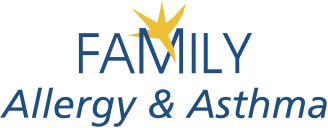Trick-or-Treating Safely with Allergies and Asthma
Food Allergy Awareness for Halloween
Teal is becoming a more and more popular color for Halloween! The Food Allergy Community of East Tennessee started the Teal Pumpkin Project as a local food allergy awareness campaign; in 2014 it was launched nationally. The Teal Pumpkin Project “promotes inclusion of all trick-or-treaters” during Halloween events. Those participating can place a teal pumpkin or sign in front of their home to indicate they have non-food treats available.
Non-food treats like glow sticks or small toys can allow all children to participate. Many families give out both food and non-food treats, just be sure to keep the treats in separate bowls.
Additional Food Allergy Tips for Halloween
- Miniature-sized candy bars can have different ingredients that regular sized candy.
- Talk to your child about turning down treats like cookies or other baked goods. Before you head out for the night, remind your child it’s okay to politely say no to food that might not be safe.
- If you visit houses who are not participating in the Teal Pumpkin Project, you can hold a “treat swap” with your child after trick-or-treating to swap out any unsafe candy with a safe treat.
- For other tips or information on the Teal Pumpkin Project visit FARE’s website.
Latex, Nickel, and other irritants during Halloween
While peanuts, milk, and eggs are common allergens found in Halloween treats, they are not the only allergens and irritants around. Here are a few more allergens to look out for this Halloween:
- Some costumes have latex, especially masks. Latex is also sometimes used in makeup to create scars and gashes. Be sure to check the ingredients of any costumes and makeup.
- Nickel is another culprit found in some accessories and props. Items such as fake swords, any jewelry, belts or even a wand can contain nickel. Some online sites list the materials in costumes and accessories, but many do not so be cautious when ordering.
- When choosing non-food items to giveaway, be mindful of allergies to latex or nickel.
- Halloween night you’ll be visiting many people’s homes that may have different allergens that may not bother them. Their black cat may add to their Halloween decor, but it can be scarier for those with pet dander allergies.
- In addition to the chemicals that can be found in different makeup, hair dyes, and perfumes. These can also bother those with skin sensitivities or those whose asthma is triggered by fragrances.
Airborne Allergens during Halloween
Many Trick-or-Treating and similar Halloween events throughout October are held outside. Luckily, by late October ragweed pollen may no longer be in the air. However, there are still a few airborne allergens and irritants around. Those with allergies and asthma should be aware of the following:
- When decorating and digging out old costumes don’t forget about the dust mites that may have gathered. Wipe off old decorations and wash old costumes before the dust sends you sneezing.
- Leaves and hay bales can contain mold. Pumpkins can also mold, so be sure to get rid of any Jack-O-Lanterns promptly after Halloween.
- Haunted houses and some not so haunted houses may use fog machines to make the night even spookier. Some machines produce fog in ways that are safer for those with asthma. However, it’s important to be careful around anything that is putting particulates in the air. If you have a fog machine, remember to use it in a well-ventilated area.
Remember to carry your emergency medication.
Whether you are just heading out around the block or going to another Halloween event, don’t forget to bring your emergency medication.
- Those with life-threatening allergies should bring their epinephrine auto-injector with them while trick-or-treating, in case of coming into contact with allergens.
- People living with asthma should bring their inhaler with them in case they come into contact with asthma triggers.
- For younger children, talk to them about waiting until the end of the night to eat their candy. This will help them stay safe along the route!
- Make sure any other adults going with your child knows about their allergies and asthma. Discuss an emergency plan with them; if you are manning the candy and safe treat bowls at your own home, you may want to show them how to use the emergency medication.
Have a fun and safe Halloween!
It’s starting to get chilly here in Kentucky and Indiana! Cold, dry air can also be a trigger for asthma attacks so bundle up if it gets too cold out. Halloween is a fun holiday and can be fun for everyone! Happy Halloween!



